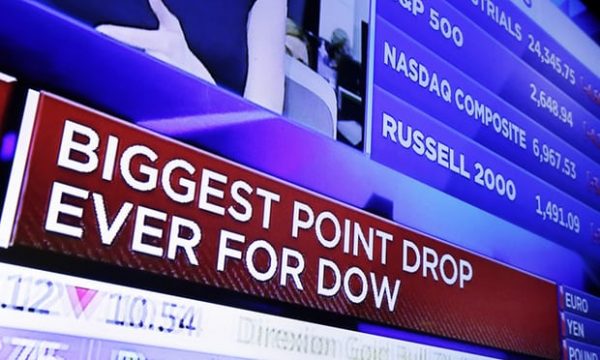 Following a record tumble of US stocks on Monday local time, here is a look at some of the worst crashes in history.
Following a record tumble of US stocks on Monday local time, here is a look at some of the worst crashes in history.
US stocks took a historic tumble on Monday, with the blue-chip Dow Jones Industrial Average at one point losing almost 1,600 points, the biggest-ever dip during trading, before recovering somewhat to close down 4.6 percent.
While sending waves through the global financial system, Monday’s swoon – which ended at 23,923.88, erasing all of this year’s gains – was far from Wall Street’s most devastating. Below are some of its worst crashes and corrections.
Black Monday
On October 19, 1987 – almost 58 years to the day after the Wall Street crash at the start of the Great Depression in 1929 – the Dow Jones Industrial Average lost a stunning 22.6 percent, falling 508 points to close at 1,738.74.
Analysts blamed the crash – which was the equivalent of more than 5,500 points in today’s terms – on factors including selling in computerized trade, over-valuation and collapsing oil prices after markets had soared earlier that year.
Attacks of September 11, 2001
Stock markets were shut for a calendar week after terror attacks on New York and Washington left close to 3,000 people dead.
Wall Street fell precipitously in the week after the attacks, with the Dow sinking 7.1 percent, or 684 points on September 17, the first day trading resumed. By noon, financial giants JPMorgan Chase and Citigroup were both six percent lower.
The 2008 global financial crisis
At the start of the financial crisis, the Dow suffered what was then its biggest one-day point drop ever on September 29, 2008, losing seven percent, or 778 points, after lawmakers failed to adopt a $700 billion bailout plan – erasing more than $1 trillion in market value.
Investors dumped stocks on fears Congress would not be able to pass a rescue plan to unfreeze US credit markets, with banks hoarding cash as the effects of the sub-prime crisis cascaded through the financial system.
The Brexit shock
Wall Street got a serious case of the jitters the day after British voters’ shock decision to exit the European Union. On June 24, 2016, amid uncertainty of the economic consequences of Britain’s secession, all three major indices erased year-to-date gains by falling more than three percent, with the Dow falling 611.21 points, or 3.4 percent, to close at 17,399.86.
The Crash of 1929
The most devastating Wall Street crash occurred over several days in 1929 and preceded the start of the Great Depression. Markets had soared in the 1920s, based to a large extent on deceit, speculation and unsustainable margin-buying, before falling off a cliff.
On October 28, 1929, the Dow fell 12.8 percent, or 38.33 points, the height of the worst financial panic Americans had ever seen, feeding into misery that would last for years.
SBS

Leave a Reply
You must be logged in to post a comment.